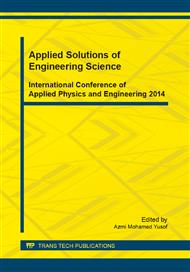p.100
p.106
p.111
p.118
p.123
p.128
p.137
p.143
p.148
Retrofitting of a Double Unit Tunnel Form Building Using Additional RC Wall, Steel Angle and CFRP
Abstract:
Tunnel form construction is widely known as modern construction method that enables the construction of horizontal and vertical elements simultaneously. It is quickly construct low cost, high quality and earthquake safe to construct cellular buildings. Main objective of this study is to determine the seismic retrofitting performance of a double unit tunnel form building when retrofitted using additional RC wall, steel angle and Carbon Fiber Reinforced Polymer (CFRP) when tested under in-plane lateral cyclic loading. A comparison of tunnel form building was made before and after retrofitting in terms of lateral strength, stiffness, ductility and equivalent viscous damping. Result indicates that retrofitting method using additional RC wall, steel angle and CFRP was able to increase the lateral strength, ductility and equivalent viscous damping under in-plane lateral cyclic loading. The result also shows the effectiveness of additional RC wall, steel angle and CFRP in improving the shear resistances and deformation capacities of concrete structures and delaying their stiffness degradation under earthquake loading.
Info:
Periodical:
Pages:
123-127
Citation:
Online since:
October 2014
Authors:
Price:
Сopyright:
© 2014 Trans Tech Publications Ltd. All Rights Reserved
Share:
Citation:


